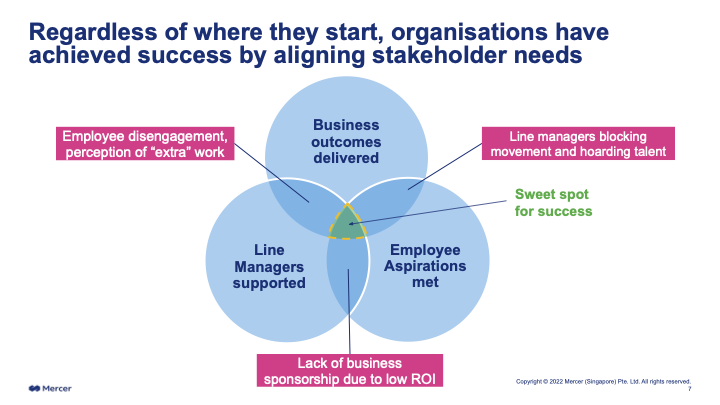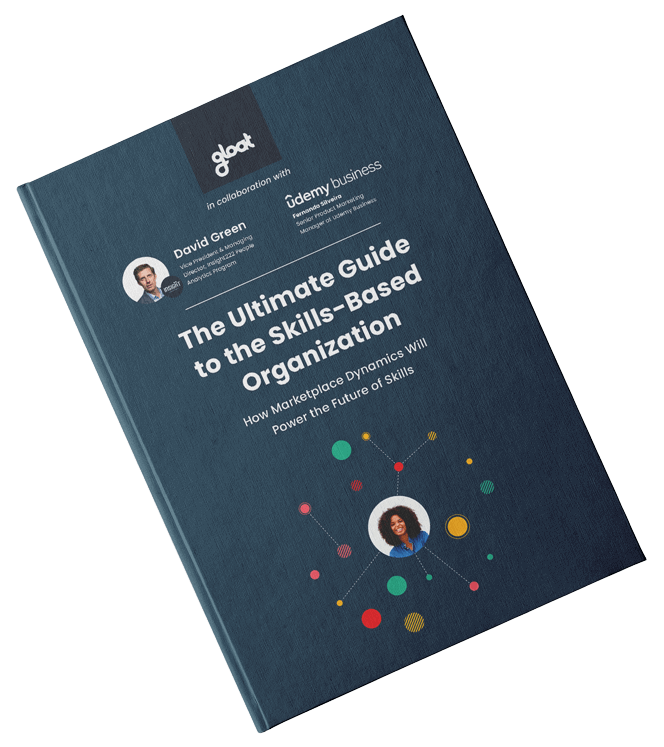Upgrade your skills strategy with tips from Mercer and Standard Chartered Bank
Top skills experts explore how to kick your transformation into overdrive

Skills-based operating models are the new gold standard for talent management—but for many leaders, this shift is more aspirational than it is tangible. While more than 90% of executives are eager to embrace skills-based strategies, only 20% think they’re ready to tackle this challenge.
Legacy mindsets and outdated technology are often to blame for the disconnect between ideating a skills approach and putting it into practice. Fortunately, with the right tools and tactical changes, leaders can empower their organizations to place skills at the center of every initiative.
To find out what it takes to bring skills-based strategies to life, we caught up with a few leaders at the forefront of these transformations: Mercer Partner Lewis Garrad and Associate Principal Chitralekha Singh, and Standard Chartered Bank Global Transformation Head Nina Santana-Sweeney. All three had important advice for executives who are looking to launch skills initiatives that move the needle, so we’re sharing the top takeaways you need to know to start embracing these strategies.
5 tips to maximize the results of your skills-based strategy
According to our skills transformation experts, here are the most important steps leaders should take to drive impact with skills strategies:
#1. Put data at the center of workforce planning decisions
Workforce planning decisions must be based on more than headcounts and capacity levels. As consumer expectations evolve and skill gaps widen, it’s up to leaders to ensure their workforce has the capabilities needed to deliver on strategic priorities.
More often than not, executives will need to look across the aisle and begin collaborating with various departments to get key projects across the finish line, as Santana-Sweeney explains. “Today, we can’t solve a problem with one business function alone. Our responsibility as HR leaders is to take the business on that journey.”
Beyond streamlining collaboration, Santana-Sweeney touts talent marketplaces as a powerful tool for gaining the data-driven insights needed to make smart decisions about how to deploy talent effectively. Reflecting on the impact that Standard Chartered Bank’s platform has had across her organization, she notes, “Having a talent marketplace allows us to do a lot of things with the data we produce. If we make a case that we don’t need to be hiring all of these people because we have a lot of people we can quickly upskill to get the job done, that changes the conversation.”
#2. Harness AI innovations to take skills visibility to the next level
Even the most attentive leaders won’t be able to keep tabs on all the skills their workforce has. Yet, knowing the breadth of skills within the workforce is key to identifying who to tap for in-demand expertise.
Rather than guessing which employees have the knowledge they’re looking for, leaders can harness AI-powered talent management innovations to pinpoint exactly where these capabilities lie. As Garrad explains, “What we really need to do is access a skills network from within and sometimes outside of the organization. But to do that, we need a new system to be able to organize that because it’s difficult for one person to find the right skills. So we’re starting to see AI and automation playing a bigger role to help make that connection.”
#3. Say goodbye to rigid hierarchies
In addition to embracing new technologies, leaders must also shift the way they think about their organizational structure at large. Instead of assuming that employees are confined to the roles that they were hired to do, skills-based organizations recognize that every team member has capabilities that can be put into use across many different teams for a variety of projects.
In describing how the talent equation is shifting, Garrad notes, “We’re starting to see organizations take seriously the idea that we should think of organizations like organisms. The way they grow, develop, and learn is this much more organic model, and that requires a very different leadership and management mindset, but it also requires a different set of HR practices.”
Garrad uses the graphic above to illustrate the more fluid, flexible talent management approach that visionary leaders are starting to embrace. The Venn diagram shows the stakeholders leaders must consider—business outcomes, line managers, and employees—and explains why the only way to achieve success is by aligning all of them.
It also depicts the negative impacts that occur when executives only consider two of three, such as talent hoarding when only employee aspiration and business outcomes are weighed and low ROI when business outcomes are left out of the equation.
#4. Start thinking about sunrise and sunset roles
As skill needs shift, leaders may find it challenging to identify the type of expertise that is becoming increasingly important, as well as capabilities that are no longer considered in demand. By harnessing skills intelligence tools like Gloat’s Skills Foundation, executives can begin devising impactful upskilling and reskilling opportunities to ensure employees have the capabilities needed to grow with their organizations.
Santana-Sweeney shares how roles at Standard Chartered Bank are evolving to reflect shifting business priorities. “User experience, communications specialist, social media specialist, agile coach, scrum master, data scientist—those aren’t the typical roles you have in banking. So we needed to do a significant transformation,” she explains.
Rather than relying on external hiring processes that were time-consuming and costly, Santana-Sweeney describes how her organization “….looked at the skills we already had and how to shorten the time for our employees who had some of those skills so we could deploy them into more sun-rising roles.”
#5. Give everyone the chance to build on-the-job expertise
Once leaders identify the skill needs that their organization must prioritize, they should strive to give employees ample opportunities to hone this knowledge—both through content-based curriculums and experiential learning opportunities. Singh encourages executives to reevaluate existing training resources, noting, “It’s becoming more important to think from a skill-based lens about your learning and development and hiring practices.”
She goes on to describe how skill-based organizations approach projects differently by breaking them down into smaller tasks that can serve as impactful learning opportunities for employees who are looking to develop new capabilities on-the-job. “The way you give work to people is becoming more about deconstructing it into tasks and then flowing skills to these tasks to unlock greater agility and flexibility,” she concludes.
If you’re looking for more tips to help your company embrace new operating models, check out our guide to becoming a skills-based organization.






